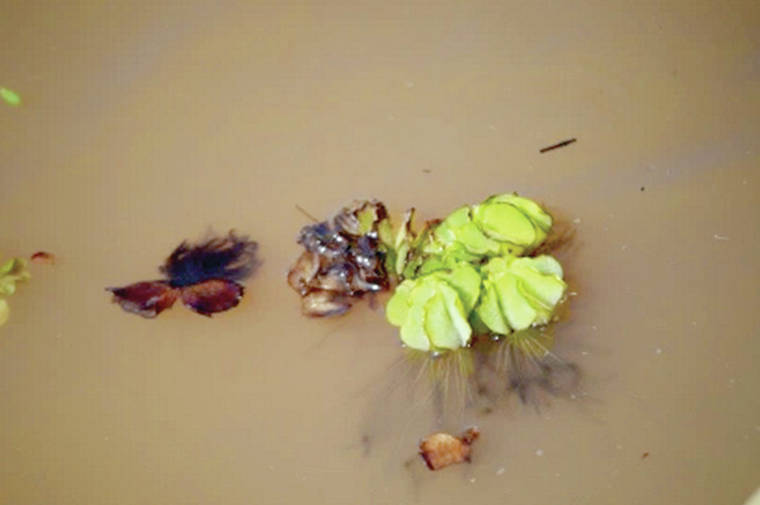KILAUEA — An invasive weed community members have been battling for years along the Kilauea River is creeping back along the banks, growing rapidly in a thick blanket of green that is known to take over the surface of lakes and slow-moving water.
Salvinia is a water plant that forms a mat along the top of the water, sending roots down through the guinea grass along the riverbanks and forming a tangled web that blocks out sunlight.
In places where this invasive plant has taken over, ecosystems are altered. Fish and limu die.
The plant is currently estimated at about 20% coverage of the Kilauea River, and growing rapidly, according to Bob Warren, a Kilauea resident who has been working with the state and other organizations to eradicate salvinia.
In 2017 a community effort brought together Kaua‘i residents like Warren, organizations like Kaua‘i Invasive Species Committee and state Department of Land and Natural Resoruces Division of Aquatic Resources to physically remove the plant.
With a small army of kayaks and paddleboards, nets and hands, and a small, vaccum-type machine DAR was trying out, the group nearly eradicated the plant.
Then, floods and record-setting rain in 2018 further washed remnants of salvinia downstream to brackish waters, where the salt content was too high for the plant’s survival.
Now it’s coming back.
“We’ve noticed it’s back along the banks, starting to get back to where it was,” Warren said. “We need to do something more to completely get rid of it.”
DAR, however, says eradication is unlikely.
“After the event (in 2017), other community cleanups were continued,” DAR invasive species biologist Kim Fuller said. “Physical removal, while rewarding in getting the community together to fight invasive species, proved to be time-consuming.”
Fuller cites staff turnover and limited funding as further reasons why eradication isn’t a consideration.
Instead, the state is focusing on preventing the spread of salvinia to other waterways — something that could happen if even a piece of the plant is transported from the Kilauea River to another waterway.
Their main strategy, according to Fuller, is community education — posting a sign that tells water users to clean their gear before leaving the area.
“One of the best things people who use waters with invasive species can do is to clean, drain and dry their gear to prevent spread to other watersheds or areas,” Fuller said.
Meanwhile, DAR is considering two main management strategies of the salvinia in the Kilauea River — physical removal or spraying with herbicide.
Physical removal, however, requires constant time and effort, and salvinia grows fast from only a small sliver of a leaf.
“Currently, DAR is not involved in scheduling any cleanups, but is supportive of any other organizations or community groups who would like to pursue this activity and could be open to collaboration in the future,” Fuller said.
Warren said he and his wife, Pam, are interested in organization another community cleanup. Those interested can email Bob Warren at ra@warren.net.
•••
Jessica Else, editor-in-chief, can be reached at 245-0457 or jelse@thegardenisland.com.





